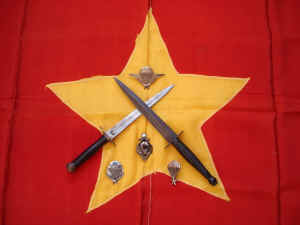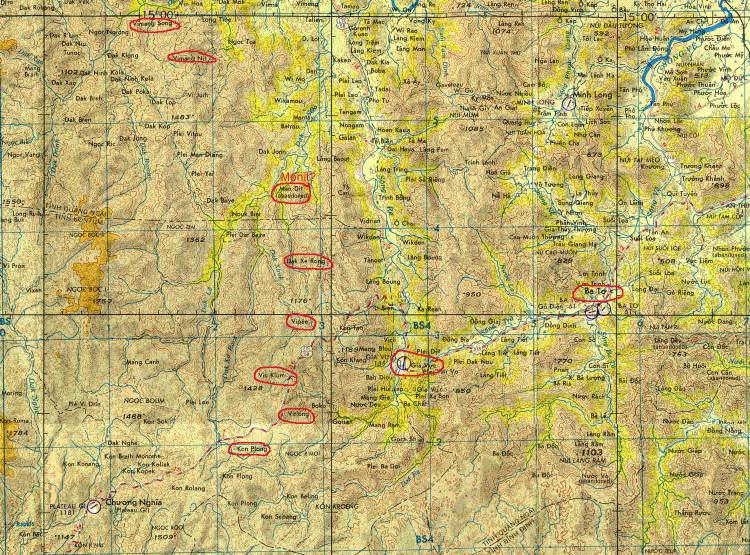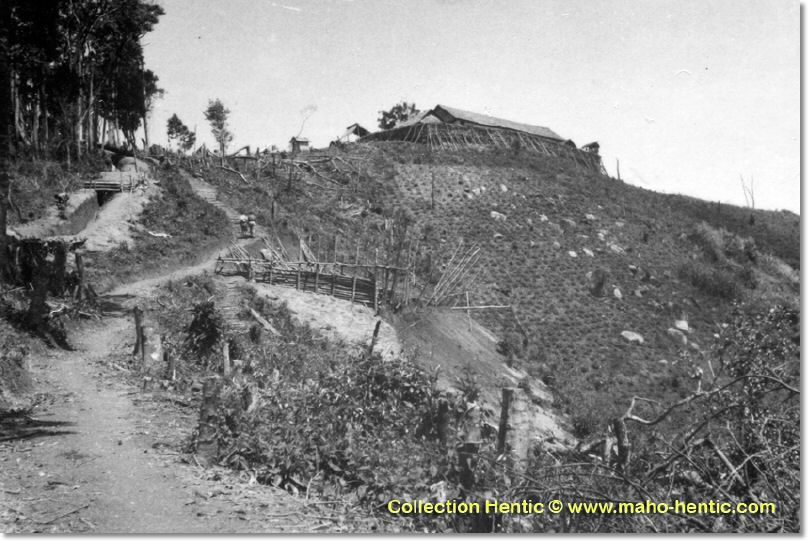|
Gia
Vuc and the Song
Re valley
under
Viet Minh
control

Photo of a Viet Minh flag donated by a
friend of my father.
The flag was captured by dad's friend
brother while he fought in Indochina unfortunately
both are deceased and no more
Information is known.
On the flag lay two
daggers and some French GCMAnd Para
insignias
Since having
learned in the 90's about the French mine
field around Gia Vuc and the hard standing
building which became the infirmary, I
always wonder if its USSF A-teams were
walking in the footsteps of a French unit
which would have been garrison there 10
years earlier?
Back in the
late 40's and early 50's the Song Re valley
and villages likes Gia Vuc, Bat To, Ha Thanh
where under firm Viet Minh control. The
situation was pretty reversed from the one
in the 60's. The French forces in the
central highlands were under strength and
ill equipped, for the French high command
this was not an important theater of
operation and therefore received low
priority on men and equipment. The French
where strongly implanted around Kontum and
Ban Me Thuot but were only able to organizing
raiding parties on area further north. One
of their most northern outpost was Kon Plong
where a lot of the operations started from.
Two of the
main units which orgenised operations in the Song Re valley was
the 4e BMEO ("Bataillon
de Marche Extreme Orient") and the GCMA
“Groupement
de Commandos Mixtes Aéroportés”
the French Special Forces in Indochina.
Here
is a list of some of the recorded operations
they did. (please note there is probably
more and the period from 1953 -54 is unknown
but this is all I have found so far)
Operations
relating to Gia Vuc with the
4e BMEO, 1949-1951
This come
from a French man
who has retraced the
two tour of duties (just
under 5 years) of his uncle
Maurice Millour in
Indochina. http://philippe.millour.free.fr/index.html
On his
first tour (37 months,
1948-51) Maurice Millour
served with the 1/3ème BMEO
and then 16e/4ème BMEO (16th
Company, 4th Battalion de
Marche Extreme Orient) at
the outpost of
Kon Plong in the central
highlands, an outpost about
100k North East of Kontum
situated on an elevated position
nearby the dirt road /trail
leading towards Gia Vuc, Ba
To and finally the coast
(what will be LTL58
during the Vietnam
war.)
The Kon
Plong outpost was surrounded
by a vast expanse of forests
and mountains, it was built
on a small hill above a
large valley housing a
Montagnard village. The
outpost was entirely made of
logs, with the exception of
two brick buildings and a
few tin roofs. The main
building was approximately
25 m long and 5 to 6 m high
and wide with at one end the
infirmary and the other end
the radio room. Its most
vulnerable part was the one
facing the meadow and was
made of a log wall pierced
with fire ports. The post's
enclosure was also made of
logs: two parallel walls
spaced 60 to 70 cm apart,
filled with pebbles and
earth, all reinforced with
split bamboo set between the
logs to limit erosion by
rain. The build was carried
out without a single nail
and was held together with
braided rattan. During heavy
showers, running water did
erode its construction
resulting in holes which for
ever needed filling up.
The 4eme BMEO consisted of
one HQ company and 4 combat
companies (13 to16 Co)
totalling around 1000 men
plus a training company the
17th
Co.
The combat
companies had a strength of
around 173 men organised
into 4 platoons with 3
squads per platoon. Each
company had 2 French
Officers, around 15 French
or indigenous NCO and
another 10 French corporals
or PFC or soldiers. The
montagnards were spread
within the four companies
according to their ethnic.
14 &16th been Sedang,
the 15th Djarais and the HQ
and the 13e with a mixture
of both ethnics.
Armament
of the 16th Co comprised of
one heavy machine gun FM
24.29, a 120mm mortar in Kon
Plong oupost, one 50m mortar
for external operations, and
a few grenade launchers.
The NCO had
MAS
38 or STEN machine guns and
most of the troop had old
WWII worn out Canadian
rifles.
1949
Early in
1949 Lieutenant Jaques
Pierre arrived in Ban Me
Thuot operational area and
in February took command of
the Kon Plong garrison which
was under strength.
On the
25th of May, Lt Pierre left
the Kon Plong outpost at the
head of reinforced platoon
of about 50 men, including
seven Europeans. During this
operation which did last two
days, this small troop
reached the
valley
of
Song Re
by Viklum and Violac, then
went up the right bank of
the stream until Gia Vuc.
Lieutenant Pierre noted that
the hamlet of Gia Vuc was
home to a Vietminh food
supply centre, whose staff,
estimated at one section,
has fled on their arrival.
After setting fire to the
food depot, the reinforced
platoon of the 16/4eme BMEO
headed back to Kon Plong via
sometimes very steep paths:
a stretch of less than ten
kilometres took over eight
hours. This operation was
one of the first French
reconnaissance in the Song
Re Valley which was under
Vietminh control.
On October
14, a reconnaissance party
send in the Song Re Valley
three days earlier returned
to the Kon Plong outpost.
They had been ambushed
twice, north of Gia Vuc and
east of Kon Plong, resulting
into one KIA and two WIA.
During the two ambushes, PFC
Bellei, a Kon Plong medic
who accompanied the
patrol, rushed
forward several times
while under fire to attend
the wounded. For his bravery
and dedication, he received
3 regimental citation with a
Croix de Guerre with bronze
star.
The two
wounded were evacuated the
next day to
Pleiku
Hospital
.
1950
In
February 1950, Hre
Montagnards who had been
forcefully enrolled into the
Vietminh People's Army
revolted. After having
killed their cadres and Viet
Ming commissars, they
approach French posts to ask
for their protection. Among
these posts was Kon Plong.
Lieutenant Pierre, the young
and new CO of Kon Plong
quickly realise the
potential of that situation
and supported the Hre
revolt. He also organizes
volunteers into a Hre
paramilitary units of
partisans under the name of
"Action Hre".
On April 7
operation "Adrien"
was launched to support the
Hre uprising and to drive
back Vietminh troops from
the Song Re valley towards
the coastal plain of Quang
Ngai. This
newly formed "Groupe
Mobile" (Mobile Task
Force) was made of about 600
men with detachments from the
2e BEP, the 1e
BPC
and the II/2ème
REI
as well as a newly formed
and poorly trained unit of
150 Hre partisans.
From 7 to
13 April, the group moves
from Kon Plong to the
village of Gilang via
Vitiong, Viklum, Vipée, Dak
Xérong, Monit, then the
valley of Song Ré until Ta
Ma, and finally Gilang.
During this part of the
operation, only forward
element made sporadic
contacts with the Viet Minh.
From the
14th of April a landing
strip, drop zones and a
field first aid post were
established in Gilang.
Reconnaissance operations
were launched in that area
resulting in casualties for
the 2ème BEP et du 2ème
REI
.
By the 22nd of April,
it was established that 5
Vietminh battalions (4000
men) were now in that area
and were closing in onto
Gilang, so it was decided to
abandon the Song Re valley
and fall back onto Kon Plong.
A follow
up operation "Gien"
took place from 8 to 12 May.
The operational element was
another Mobile Task Force
made up of the 15th and 16th
Cie of the 4th BMEO, the
"Compagnie de Marche"
of the 1st
BPC
(Colonial Parachute
Battalion) and a section
from an
Officers
School
platoon. It mission was to
drive the Viet Minh out of
the hamlet. Gia Vuc to set
up a nearby outpost and
recruit local troops.
The
operation "Gien"
did not succeed as much as
the region was found empty
of any significant number of
enemies. Also the lack of
trails, would have made the
implantation of an outpost
not viable due to being so
much isolated without the
chance of been rescued in
time by road or trails.
Following
the "Adrien"
operation, it was decided to
organize part of the Hre
into a structured military
unit. This lead in mid-June
to the creation in Kon Plong
of
USM
26 (
USM
: " Unité Supplétive
Militaire" (Paramilitary
Unit) with a strength of a
company. Its initial
armament was two FM Bren and
a hundred rifles.
By mid-July 1950 its
infrastructure was just
three European
non-commissioned officers.
This unit will be later
reinforced with automatic
weapons and transformed into
CCS
26 (
CCS
: Compagnie de Commandos
Supplétifs, (Paramilitary
commando unit).
Corporal Rene
RIESEN from the 4e BMEO and
author of " Mission spéciale
en forêt Moï ".This
is the only book regarding
the French involvement with
the Hre montagnards which had
been
translated into
English (new title
"Jungle Mission"
in 1957).
R Riesen
received the task of
supervising the Hrés
volunteers, instructing them
in guerrilla warfare and of
forming villages self-defence
groups [also known as
"militia" or
"goums"]. René
Riesen did spend several
years with the Hrés,
becoming their war chief
under the name "Ba Tamoï"
(the father of Moïs), or
"Ba tchiac gaho tabouac"
(the white-haired father).
One of Riesen's first
missions was to form a unit
of partisans in the
village
of
Kon Pong
, about 20 kilometres south
of Kon Plong, with the aim
of creating an outpost and
raising a militia. The
control of this village was
indeed very important for
the 16/4 BMEO since it
covers, on the north, the
position of Kon Plong and,
westwards, the Kon Braih
redoubt on the road joining
Kontum and Kon Plong.
In June,
many trails improvement
works were carried out in
the sub sector of Kon Plong,
either south to Kon Braih or
north to Kon Kléang or Gia
Vuc.
On 31
December, the "Petits
Hrés" self-defence
group in the Mang Mou / Mang
Rha area (Song Re Valley),
armed with an FM, three MGs
and one hundred and sixty
rifles, turned themselves to
the Vietminh following the
betrayal of most of their
troops.
Early
January, information
confirmed by patrols
indicated the presence of
400 Vietminh around Mang Mou
and Mang Rha, and another
1,200 in the Gia Vuc valley.
Gaston
Mille commander of the 4th
Montagnard battalion (the
old 4th BMEO) decided to
organize combat operation
"Omer" in the form
of a raid to the above
Vietminh controlled area to
recover all or part of the
lost weapons as well as to
collect information in view
of a possible re-occupation
of the villages of Mang Mou
and Mang Rha. After 5 day of
patrolling in and on the
high ground of the Song Re
valley, no contact was made
with the enemy which had
disappeared and the local population
appeared non co operative
and under Viet Minh control.

Operations
relating to Gia Vuc with the
GCMA, 1951-1952
By
1951, the CEFEO, "Corps
Expéditionnaire Français
en Extrême-Orient" had
new counter-guerrilla units
at its disposition thanks to
their new commander in
chief, General
de Lattre de Tassigny. These
newly formed
counter-guerilla units were
the “Groupement de
Commandos Mixtes Aéroportés”
(GCMA) and the Commandos
Nord
Vietnam
both were using para
military locally raised
indigenous forces and were
often operating in the Viet
Minh back yard.
The "Action Hre" formed
a year earlier by Lt
Pierre from Kon Plong was
passed over to Captain
Hentic from the GCMA after having been given
the mission of reorganising
it into Military fighting
unit for the GCMA.
In
autumn 1951, Cpt Hentic with
2 or 3 French cadres and a
Hre forces of 150-200 men,
carried out more raids deep
into Viet Minh controlled
territory. These raids
lasted from three weeks to
six weeks reaching places
like Vidzen, Vibliang and Gi
Lang and rallied more troops
and population through the
lower valleys of the Son Hre.

Trail Trail leading to ViMuk
outpost, you can see the
outer earth and wood berm
defending
the French small outpost.
1952
26
April 1952, Cpt Hentic with
less than three Hre "three
centaines" left Gia Vuc
and crossed the Song Re on
the 27th and attacked and
took Ba To in the morning of
the 2nd of May. They
destroyed all V-M
installations and
ammunitions depots as well
as the VM 108 Regiment
headquarters.
Then they disappeared in the
jungle before the Viet Minh
could react.
By
the fall of 1952 with
a Vietnamese Commando and a
Hre platoon (approx 100 men),
Cpt Hentic achieved a two
months deep reconnaissance
via Dak To into Laos leading
to Attopeu. In its
path, they destroyed Viet-Minh
bases and laid booby traps
on the Viet-Minh trails.
During this reconnaissance
mission they discovered in
Laos a well camouflaged
large tails network, Viet
Minh staging and rest areas,
food dumps etc. This was the
first sighting of the famous
Vietnam Ho Chi
Minh trail!
Unfortunately,
this is all I have for the
moment which lead us to the
end of 1952 where trails leading to
the valley of the Song Re
and Gia Vuc were improved to
facilitated a possible
future French implantation
to controlled that area.
By December 1952, Gia Vuc was
still under Viet Minh
control with no sign of
having a French oupost but
the war went on for a
further two years!
Information
translated by myself come
from Philippe Millour
website http://philippe.millour.free.fr/index.html
as well as from Cpt Hentic's
daughter, Anne Alexandre, http://www.maho-hentic.com/
and books like Jungle
Mission, R Riesen; Le
Silence du Ciel, R Riesen;
Les Heros Oublies, Erwan
Bergo.
This
is a fascinating
part of Gia Vuc
history and if
you want to
discover more
regarding the
French Special
Forces and the
4th BMEO who
both beat the
bush in the
Central
Highlands, visit
my French
Indochina war
section.
 Enjoyed
your article and
web links for
"Gia Vuc
from
1945-54".
Once while
returning from a
local security
patrol (summer
of 1967) by way
of the
hill/mountain
located
immediately to
the NE of Gia
Vuc I spotted an
old rusted out
MAT-49. It
was located
about 3-4 foot
down on the side
of a 5-6 foot
gulley. I
have always
wondered about
how it came to
be there and
wondered about
it's history.
I knew that Gia
Vuc had been an
old French fort,
but did not
realize the
extent of Viet
Minh activity in
the area. Thanks
to SFC
Ron Knight
(Demo) Enjoyed
your article and
web links for
"Gia Vuc
from
1945-54".
Once while
returning from a
local security
patrol (summer
of 1967) by way
of the
hill/mountain
located
immediately to
the NE of Gia
Vuc I spotted an
old rusted out
MAT-49. It
was located
about 3-4 foot
down on the side
of a 5-6 foot
gulley. I
have always
wondered about
how it came to
be there and
wondered about
it's history.
I knew that Gia
Vuc had been an
old French fort,
but did not
realize the
extent of Viet
Minh activity in
the area. Thanks
to SFC
Ron Knight
(Demo)
|

